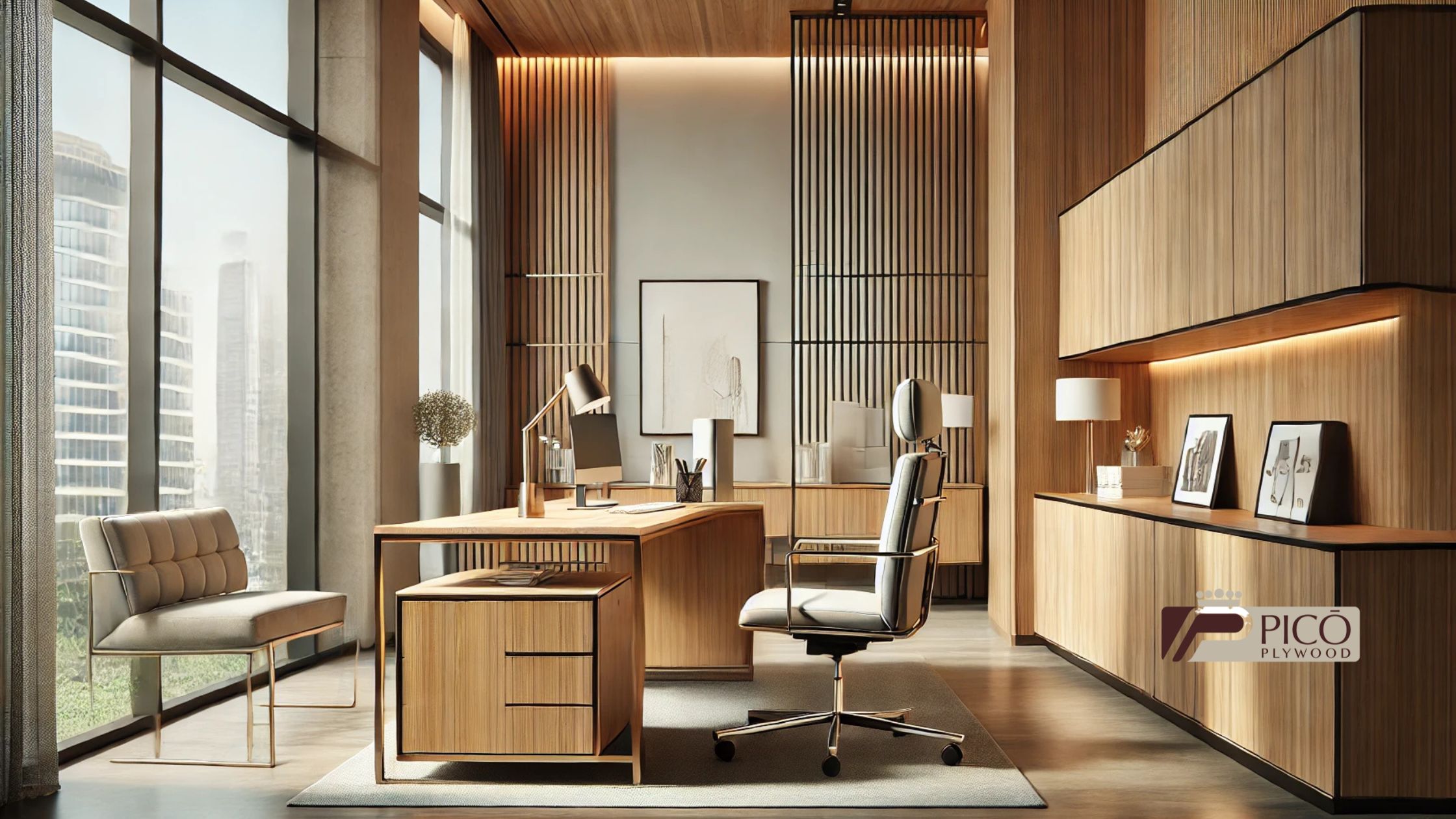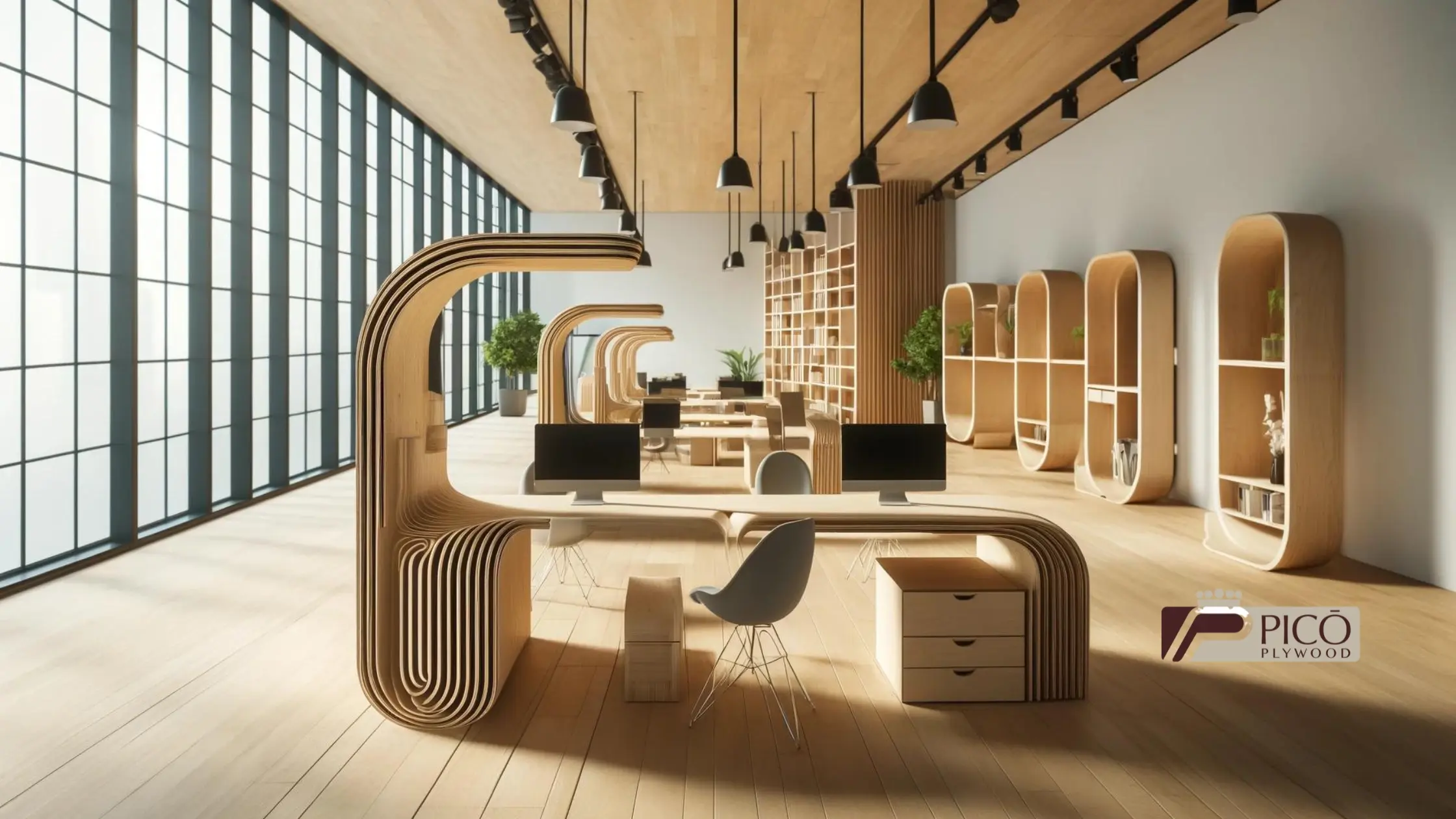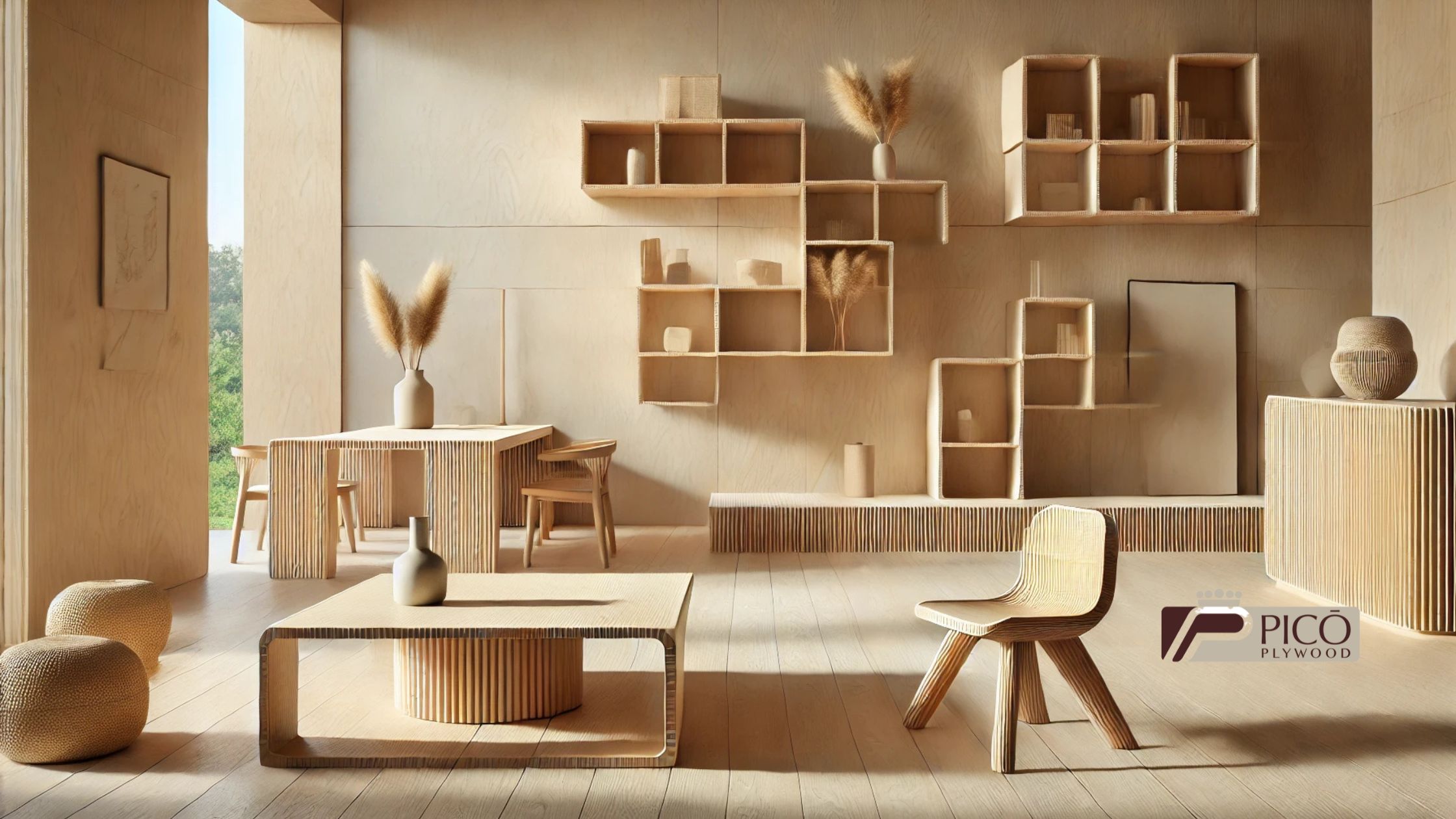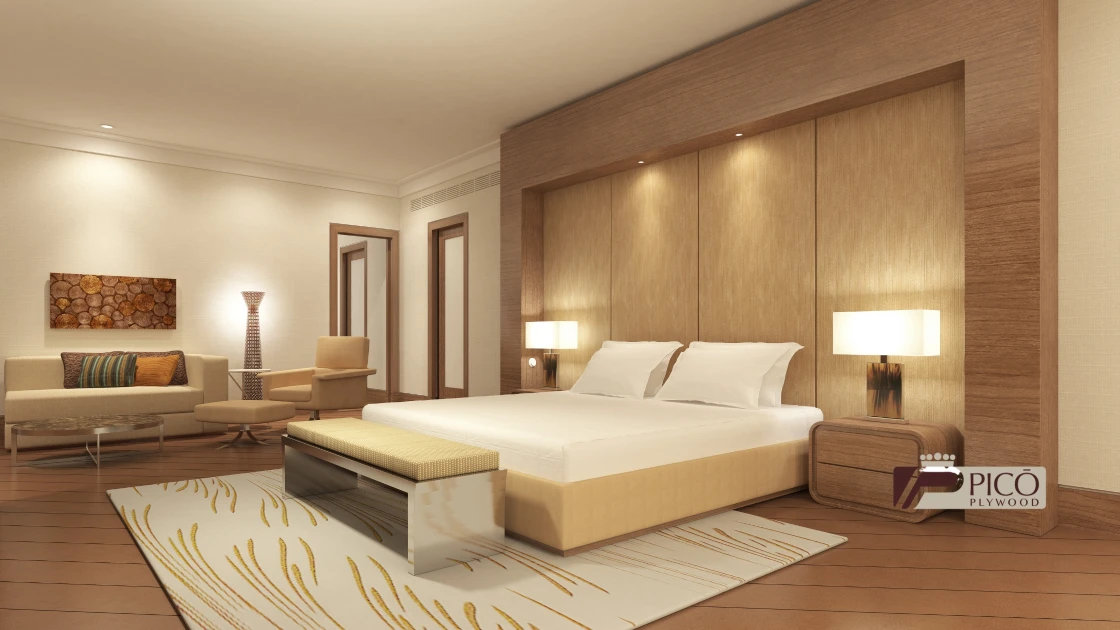pico Plywood Contact
Contact Information
To learn more about our Plywood Products or discuss your project requirements, please reach out to us through the following channels.

Table of Contents for the Article
Furniture grade plywood is a versatile and durable material that has become one of the main choices in the furniture industry due to its balance of quality, durability, and cost.
Unlike solid wood, plywood is made up of several thin layers of wood, bonded together with adhesives under high pressure. This provides greater stability and resistance to warping, making it ideal for the production of durable and attractive furniture.
Furniture grade plywood is a specific type of plywood designed and manufactured to meet the demanding aesthetic and structural standards required in furniture production. This type of plywood is characterized by:
They are free of defects such as knots or imperfections that could affect their appearance.
The internal layers are arranged in a cross pattern, which increases the material’s strength and reduces the risk of warping or cracking over time.
Furniture plywood is designed to be painted, varnished, or laminated, providing an excellent base for a high-quality decorative finish.
There are several important differences between furniture grade plywood and other types of plywood used in construction or more basic projects:
Unlike standard plywood, furniture grade plywood uses high-quality veneers for the outer layers to ensure an attractive and smooth appearance.
Furniture grade plywood is designed to support intricate woodworking details, such as edges and bevels, making it ideal for projects that require a high level of aesthetic precision.
Furniture grade plywood has fewer voids or internal imperfections, ensuring greater consistency in structural performance, which is especially important for pieces that bear weight or constant tension.
This combination of aesthetics and functionality makes furniture grade plywood a preferred choice for carpenters and furniture manufacturers worldwide.

Furniture grade plywood stands out for a series of properties that make it a highly valued material in the furniture industry. These properties, ranging from strength to surface quality, are fundamental in ensuring durable, functional, and aesthetically appealing furniture.
One of the most notable features of furniture grade plywood is its strength and durability. This is due to its cross-laminated structure, which evenly distributes stresses, providing greater resistance to bending, cracking, and warping. Unlike other types of wood or composite materials, plywood maintains its structural integrity even under intensive use conditions. Thanks to its strength, it is used in the manufacturing of high-traffic furniture, such as tables, shelves, and cabinets, where a material that can support weight without compromising its shape or stability is required.
Furniture grade plywood is incredibly versatile, adapting to a wide variety of designs and applications. Its ease of cutting and shaping allows designers and carpenters to use it in all types of furniture, from simple shelves to complex decorative pieces. Additionally, it can be laminated, painted, varnished, or veneered, offering limitless possibilities in terms of finishes and textures. Its versatility makes it a popular choice for both custom furniture projects and large-scale productions in the industrial sector.
One of the reasons why furniture plywood is so appreciated is its excellent surface quality. The outer faces are designed to be smooth and homogeneous, allowing for high-quality finishes without the need for additional treatments. This feature is essential when seeking a flawless aesthetic result, as the surface of the plywood is ideal for varnishing, lacquering, or being covered with other decorative materials, such as fine wood veneers or laminates. Moreover, the quality of the surface finish ensures that the furniture is not only functional but also visually appealing, which increases its market value.
Together, these properties make furniture grade plywood a reliable material for both manufacturers and consumers looking for durable, versatile furniture with a superior finish.
The use of plywood in furniture manufacturing offers multiple advantages that make it a preferred choice for both manufacturers and designers. This material not only ensures the quality of the final product but also provides benefits that impact the production process, sustainability, and efficient use of resources.
One of the main advantages of plywood is its excellent dimensional stability. Unlike solid wood, which can warp or expand with changes in temperature and humidity, plywood is much more resistant to these factors. This is due to its layered construction, where each sheet of wood is oriented in opposite directions, reducing expansion or contraction in any direction. This dimensional stability is crucial in furniture manufacturing, as it ensures that the pieces maintain their shape and functionality over time, without suffering warping or cracking.
The use of plywood also contributes to sustainability and the efficient use of natural resources. The production of this material uses fast-growing woods, and in many cases, lighter or recycled woods are utilized in its core, reducing the amount of resources needed to manufacture high-quality pieces. Additionally, by using thin sheets of wood instead of solid blocks, the utilization of raw materials is optimized, generating less waste. This manufacturing approach makes plywood a more environmentally friendly option, helping to reduce deforestation and promoting a more conscious use of natural resources.
Plywood is an extremely manageable and easy-to-process material, facilitating its use in furniture manufacturing. Thanks to its uniform structure, it can be cut with precision without chipping or damaging easily. Furthermore, it is compatible with a wide range of woodworking and machining techniques, allowing manufacturers to work more quickly and efficiently. This ease of processing not only saves time and costs in production but also enables the creation of customized furniture with precise details, from simple shapes to more complex designs.
In summary, plywood offers key advantages in furniture manufacturing, providing stability, sustainability, and ease of processing. These characteristics position it as a preferred option in the industry, ensuring a balance between quality, cost, and respect for the environment.

When choosing the right plywood for furniture manufacturing, it is essential to understand the different varieties available. Each type of plywood offers specific characteristics that are better suited to different needs, depending on the type of furniture, the intended use, and the desired finish. Below are some of the most commonly used types in furniture manufacturing.
Ceiba Plywood Board is a high-quality plywood product made from Ceiba veneers. Ceiba, also known as Kapok, is a tropical hardwood species renowned for its strength, lightness, and sustainable characteristics. The Ceiba veneers are meticulously bonded together using advanced adhesive technology, resulting in a durable and eco-friendly plywood board.
Okoume plywood stands out as a lighter and more economical option compared to other woods, but without compromising quality and performance. Okoume is a tropical wood that has a light color, making it suitable for furniture that requires finishes in light or natural tones. Thanks to its lightness, it is ideal for furniture that needs to be easily transported or assembled, such as modular or quick-assembly furniture. Although it is not as dense as birch, okoume plywood is strong enough to ensure durability in moderately used furniture, especially indoors.
Ilomba Plywood Board is a high-quality plywood product with a core made from Ilomba wood. Ilomba is a hardwood species known for its elegant appearance, fine texture, and excellent structural properties. The Ilomba veneers used in the plywood board are carefully selected for their quality and consistency, resulting in a reliable and visually appealing board.
In summary, Ceiba plywood, Okoume plywood, and Ilomba plywood all offer ideal solutions for different types of furniture, depending on the needs for strength, aesthetics, and functionality of each project.
Plywood has gained popularity in the design and manufacture of furniture due to its versatility, strength, and attractive aesthetics. This material offers excellent value for money and is used in a wide range of applications. Below, we explore some of the most common applications of plywood in furniture creation.
Plywood is an ideal choice for constructing cabinets and cupboards due to its durability and dimensional stability. These pieces of furniture require solid and robust structures to support the weight of stored items and ensure their longevity, and plywood perfectly meets these requirements. Additionally, the ease of cutting and finishing plywood allows for the creation of custom cabinets and cupboards in a variety of styles and sizes. Being resistant to warping and cracking, it is a perfect choice for kitchen, bathroom, and bedroom cabinets, where durability and an attractive finish are essential.
Another common use of plywood is in the manufacture of tables and desks. The combination of strength and lightness of plywood makes it an excellent option for creating flat surfaces, such as tabletops, that require resistance to weight and bending. Moreover, its ability to be covered with wood veneers, laminates, or other decorative finishes allows it to adapt to a wide range of design styles, from minimalist to rustic or contemporary. Tables and desks made from plywood offer excellent long-term durability, remaining aesthetically pleasing even with daily use.
Plywood is also a prominent material for the manufacture of shelves and bookcases due to its ability to support heavy loads without warping. Thanks to the arrangement of its internal layers, this type of wood provides greater resistance to twisting and buckling compared to solid woods or MDF. This makes it an excellent choice for storage furniture that requires robust and resilient structures, ideal for holding books, decorations, and other heavy objects. Additionally, its ease of being cut into various shapes and sizes allows designers to create custom shelves that fit perfectly into the desired space and style.
The versatility of plywood also extends to its use in decorative panels, adding a unique aesthetic touch to any space. These panels can be used in furniture as well as on walls or room dividers, adding natural and sophisticated textures to interior design. Thanks to the ability of plywood to be covered or painted, decorative panels can be customized in a variety of colors and finishes. Furthermore, its structural stability ensures that they will maintain their shape and appearance for a long time, making them a perfect solution for those looking to add a decorative element to their spaces without compromising functionality.
In summary, plywood is an excellent option for a wide variety of applications in furniture design, offering strength, durability, and aesthetic flexibility in cabinets, tables, shelves, and decorative panels.

Choosing the right plywood for furniture projects is essential to ensure that the final product is not only aesthetically pleasing but also durable and functional. Below are some key considerations to keep in mind when selecting plywood for furniture.
Aesthetics are one of the most important aspects of selecting plywood for furniture. The texture and finish of the plywood can significantly affect the overall appearance of the furniture. When choosing plywood, it’s important to consider the different types of finishes available, such as natural wood plywood, which highlights the beauty of the wood grain, or painted plywood, which offers a wide range of colors and styles. It is also essential to consider the texture; some woods have a smoother finish, while others may have a more pronounced texture. This will influence the tactile and visual perception of the furniture. Therefore, it is advisable to see plywood samples in person to choose the texture and finish that best fit the desired design.
The thickness and strength of the plywood are crucial factors that should be evaluated based on the type of furniture being manufactured. For instance, furniture like tables and shelves requires thicker, more robust plywood to support weight and withstand daily use. In contrast, decorative items or lighter furniture may benefit from thinner plywood. It is recommended to consult the manufacturer’s specifications regarding the strength of different types of plywood, as well as thickness recommendations for each type of furniture, to ensure the durability and functionality of the final product.
Today, sustainability is a key aspect to consider when selecting any material, including plywood. When choosing plywood for furniture, it is essential to look for products that have environmental certifications, such as the FSC (Forest Stewardship Council) seal, which guarantees that the wood comes from sustainable and responsible sources. Additionally, the production processes used should be considered, such as the use of eco-friendly adhesives and manufacturing techniques that minimize environmental impact. Opting for sustainable plywood not only contributes to environmental protection but can also add value to the final piece of furniture, as consumers are increasingly aware of the importance of sustainability in their purchasing decisions.
By considering these key factors when selecting the appropriate plywood for furniture projects, you can ensure that the final product is aesthetically appealing, functional, and environmentally friendly. Taking the time to research and evaluate the available options will allow you to create furniture that not only meets design expectations but is also durable and sustainable.
Working with plywood for furniture manufacturing can be a rewarding and creative process. However, it is essential to follow certain practices to ensure a high-quality and durable result. Here are some helpful tips for working with this material.
Cutting and assembly are crucial stages in the production of plywood furniture. To achieve a clean and precise cut, it is advisable to use a circular saw or a table saw with a sharp blade designed specifically for plywood. This will help avoid splintering on the edges and ensure a more professional finish.
When assembling the pieces, it is important to use proper techniques to ensure a strong joint. Joints with screws, wood glue, or bonding systems are effective options. It is recommended to pre-drill screw holes to prevent the wood from cracking. Additionally, the use of staples or screws can be helpful in certain applications to provide additional support.
Plywood is a versatile material that can benefit from a variety of coatings and treatments to enhance its appearance and durability. Applying a sealer or a coat of primer before painting or varnishing can help achieve a uniform and long-lasting finish. Treatments with oils or lacquers can enhance the natural beauty of the wood while protecting it from moisture and wear.
It is important to choose suitable finishing products that are compatible with plywood and meet the aesthetic expectations of the project. Testing in a small area before applying the final finish is also recommended to ensure the desired outcome.
To maintain the beauty and functionality of furniture made from plywood, it is essential to follow a regular maintenance and care program. Cleaning the surface with a soft, damp cloth while avoiding harsh chemicals will help prevent damage. Additionally, it is recommended to apply a new coat of oil or varnish periodically, especially in areas exposed to sunlight or moisture, to maintain the protection of the finish.
When moving furniture, it is important to lift it rather than drag it to avoid damaging the corners and finish. Lastly, avoiding prolonged exposure to moisture and keeping the furniture in a temperature-controlled environment will contribute to the long-term durability of plywood.
By following these tips, both hobbyists and professionals can effectively work with plywood for furniture, achieving results that are not only aesthetically pleasing but also functional and durable. With proper preparation and the right techniques, plywood can be transformed into exceptional furniture pieces that enhance any space.
Plywood has proven to be a fundamental material in furniture manufacturing, and its relevance continues to grow as the industry evolves. The combination of versatility, strength, and sustainability makes plywood an attractive option for both designers and manufacturers. In this context, the future of plywood for furniture looks promising, driven by technological innovations and a growing commitment to sustainable practices.
Technological advancements have led to the development of plywood with improved properties, expanding its applications in furniture design. From the introduction of eco-friendly adhesives that eliminate volatile compounds to the use of recycled woods and lighter compositions, innovations are redefining what is possible in furniture manufacturing. Nanotechnology, for example, is being explored to enhance the strength and durability of plywood, promising more robust and long-lasting products.
Moreover, computer-aided design and automated manufacturing techniques are facilitating the creation of custom-made furniture, allowing manufacturers to offer unique solutions that meet the specific needs of consumers. These innovations not only improve the functionality and aesthetics of furniture but also optimize resource use and reduce waste in the manufacturing process.
Sustainability has become an essential pillar in furniture manufacturing, and plywood is well-positioned to contribute to this shift. The use of wood sourced from responsibly managed forests and the adoption of cleaner production practices are crucial to reducing the environmental footprint of the furniture industry. Additionally, the durability of plywood means that furniture made from this material tends to have a longer lifespan, reducing the need for frequent replacements and decreasing waste.
The increasing consumer demand for sustainable products is driving manufacturers to adopt more responsible approaches in material selection and processes. Sustainability certification, such as that provided by the FSC (Forest Stewardship Council) and PEFC (Programme for the Endorsement of Forest Certification), is gaining importance, giving consumers confidence that their furniture is made ethically and sustainably.
As the furniture industry continues to evolve, plywood will remain a fundamental player in creating pieces that are functional, aesthetically pleasing, and environmentally responsible. With innovations in its manufacturing and a renewed focus on sustainability, the future of plywood in furniture manufacturing is bright, promising to contribute positively to both home aesthetics and the health of the planet.
pico Plywood Contact
Contact Information
To learn more about our Plywood Products or discuss your project requirements, please reach out to us through the following channels.
Plywood supplier, Plywood boards, Veneered plywood panels, Special Plywood
Contact information

Esta web utiliza cookies para que podamos ofrecerte la mejor experiencia de usuario posible. La información de las cookies se almacena en tu navegador y realiza funciones tales como reconocerte cuando vuelves a nuestra web o ayudar a nuestro equipo a comprender qué secciones de la web encuentras más interesantes y útiles.
Strictly necessary cookies must always be enabled so that we can save your cookie setting preferences.
If you deactivate this cookie we will not be able to save your preferences. This means that each time you visit this website you will have to activate or deactivate cookies again.
Esta web utiliza Google Analytics para recopilar información anónima tal como el número de visitantes del sitio, o las páginas más populares.
Dejar esta cookie activa nos permite mejorar nuestra web.
Please enable strictly necessary cookies first so we can save your preferences!